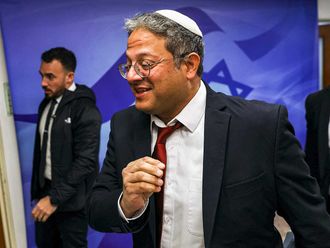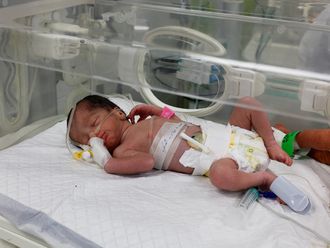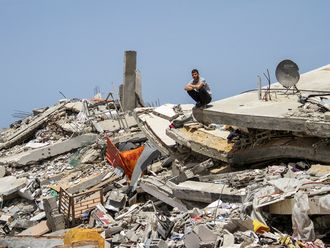Washington: When a video surfaced in January showing an American M1 Abrams tank flying the green-and-yellow flag of Kitaeb Hezbollah, the Iranian-backed militia in Iraq, US officials were aghast.
The tank was filmed as pro-government fighters repositioned military equipment to western Anbar province ahead of an assault on Daesh.
American officials eventually determined that Kitaeb Hezbollah, which the US considers a terrorist group, had not commandeered the tank. Rather, they concluded, a tank operator from the ninth Iraqi Army Division had raised the flag in a show of solidarity with Shiite militiamen joining them in the fight.
The message to the Iraqi government was clear: Militia flags need to come off all US-supplied weaponry and equipment, and fast.
The incident illustrates the challenges the Obama administration now faces in Iraq, where government troops have increasingly fused into a single force with volunteer Shiite paramilitary fighters and Iranian-backed militias. The hybrid force makes it difficult for the US to keep tabs on sensitive American-made military equipment.
In recent months, social media sites have carried a flurry of images depicting militia fighters carrying US-made semi-automatic rifles or driving US military vehicles draped with militias’ flags or insignia. Those photos are one by-product of the renewed rise of Iranian-funded and trained militia groups since Daesh swept across Iraq last summer.
“US weapons are on the battlefield — no question about it,” Ahmad Ali, a senior fellow at the Education for Peace in Iraq Centre, said. “They are in the hands of different groups, whether in the hands of the Islamic State [Daesh] or PMUs [popular mobilisation units], or the Iraqi military.”
Since they were mobilised last summer and put under formal government control, the largely Shiite volunteer forces known as PMUs have fought alongside Iraqi forces and militias such as the Badr Brigade and Asaib Ahl Al Haq, which launched thousands of attacks on US forces during the last American war there.
Members of those same militias have been accused of sectarian abuses in areas where they have battled Daesh.
Ali said another militia, Kataeb Al Imam Ali, had been seen operating black Humvees typically used by Iraq’s elite counterterrorism forces. “The Iraqi government has no consideration for public relations” in dealing with the hardline militants, he said. “It’s about the reality, and the reality is fighting ISIS [Daesh].”
Such videos and images have created anxiety in Washington, where US President Barack Obama’s strategy to fight Daesh hinges on the abilities of Iraqis on the ground. Exposed last year as a decaying and undermanned military, Iraq’s official security forces are being built back up by the US and allied trainers, but so far have failed to match the fighting power of paramilitaries also battling Daesh.
A State Department official, who, like others, spoke on condition of anonymity to discuss talks with another government, said the Obama administration had in recent months reminded the government of Shiite Prime Minister Haider Al Abadi that such equipment must be used in line with the US’ arms export law.
“That means the Iraqi security forces should not lend or provide US-provided equipment to militia forces without US permission,” the official said.
US officials, who believe they have reasonably good visibility into the whereabouts of US weaponry in Iraq, say there have been no confirmed cases of Iraqi security forces transferring US-provided equipment to the sole custody of Shiite militias since last summer.
Iraqi Defense Minister Khaled Al Obeidi said that “all weapons that the Americans are supplying are under the control of the Iraqi army.” In an interview, he said that US officials had raised the issue of American weapons leaking into the hands of other groups but that “it doesn’t happen.”
Yet keeping tabs on American weapons is a tall order given the scale of US military support to Iraq in the last dozen years. Following President George W. Bush’s 2003 invasion, the US spent more than $20 billion (Dh73 billion) to rebuild and equip Iraqi security forces. Oil-rich Iraq has also become an important arms customer for US defence firms.
Monitoring required
Under US law, the US must conduct what is known as end-use monitoring of arms it exports to other nations to ensure US-made weapons don’t go astray. While the frequency of such monitoring varies, US officials stationed at the US Embassy in Baghdad conduct checks on weapons such as armoured fighting vehicles and missile systems “as security conditions allow,” said Lt. Col. Joe Sowers, a Pentagon spokesman.
Especially sensitive items, such as Abrams tanks, Stinger missiles and night-vision goggles, require “enhanced” monitoring, including annual inventories of equipment by serial number. Last Sunday, according to one American official in Baghdad, US personnel completed an inventory of Stinger missiles and Avenger Systems, a surface to air weapon, that have been deployed to different parts of Iraq. All of the weapons were accounted for.
American officials suggest that militias may have acquired US-made weapons, such as the M16A2 rifle, on the open market. But they also acknowledge that it is difficult on Iraq’s crowded battlefield to prevent weaponry or vehicles from being utilised by various forces.
The popular mobilisation units meanwhile continue to occupy a grey area. Because they are paid by the Iraqi government and fall under government command, the Obama administration appears to have accepted that they will, at least sometimes, be using US-provided weaponry, even though they are not formally part of the Iraqi security forces.
To complicate things, the Abadi government has described both militias and Shiite volunteers as popular forces, raising the possibility that it will not distinguish between the two groups when it arms them.
Simple weapons
According to Obeidi, the popular mobilisation units have “their own simple weapons.” But Hadi Al Amiri, the influential leader of the Badr Organisation, said last year that those forces received their weapons from the Iraqi government.
Some US lawmakers are voicing doubts about how well a relatively small team at the US Embassy in Baghdad can ensure the proper custody of US-provided weaponry, especially given the limitations that US personnel face in moving around the country. “It increasingly seems like end-use monitoring is more of a goal than a reality,” said Sen. Patrick Leahy, D-Vt., who wrote a law prohibiting the US from providing security assistance to forces linked to major human rights crimes. “That means we should expect some US materiel to be used against our allies, and it may one day be used against us. More scrutiny and vetting is needed, but we also may need to consider if we can meet acceptable standards, and whether it is an acceptable risk to our national interests.”
Oubai Shahbandar, a former Pentagon analyst who was stationed in Iraq from 2007 to 2008, said that some US officials had accepted questionable Iraqi assurances “at face value.”
“Not enough policy concern is being placed on the real likelihood that US Foreign Military Funds to the Iraqi government are enabling Iranian-backed militia forces,” he said.
The Obama administration is hoping that all paramilitaries will eventually be brought under government control, once the Iraqi parliament approves a plan to establish a national guard force that would include popular mobilisation forces, militiamen and possibly Kurdish peshmerga.












